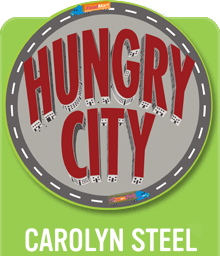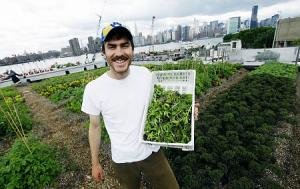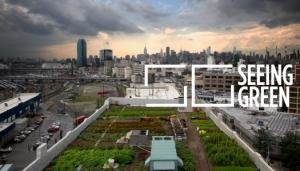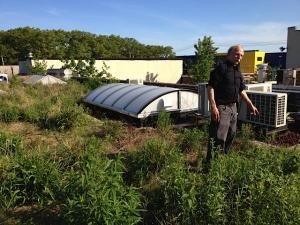NYC goes Sitopia!
Nowhere is the gathering pace of the Food Movement clearer than in New York City, whence I have just returned from a trip to speak at a conference called, appropriately enough, How Food Systems Shape Cities. Within hours of arriving, I had been asked to help shift soil and plants to create two separate urban farms: one on a rooftop above a soon-to-be-opened restaurant in Lower Manhattan, the other for an inspirational project called SNAP Gardens, which diverts food stamps towards plants and seeds, so that instead of relying on a stream of handouts, recipients are able to achieve some form of food independence:
SNAP Gardens is the brainchild of Daniel Bowman Simon, an extraordinary and intense young man in his early 30s, whose vision and persistence were in large part responsible for persuading Michele Obama to create her famous White House allotment. In an initiative called The WhoFarm (White House Organic Farm Project) he set off with his friend Casey Gustowarow to drive a bus with an organic garden on top around the country for months, collecting signatures to ‘respectfully request that our 44th President oversee the planting of an organic farm on the grounds of The White House’. As the world now knows, that request was respectfully honoured on March 20, 2009, just 70 days after the Obamas took office.
It was on that 11,000 farming road trip that a woman told Daniel that Food Stamps (which now feed 46 million Americans at a cost of $72 billion in 2010 and growing) could be used to buy plants and seeds. To ordinary mortals already engaged in a major campaign, such a snippet of information might have gone unnoticed, but to Daniel, it lit the touch-paper for the project which now dominates his life.
Daniel is by no means the only youthful crusader working to change the food system for the better in NYC. Pioneering rooftop farmer Ben Flanner, whose Brooklyn Grange Farm was the first in the city to achieve planning permission from commercial to agricultural use, is now something of a rooftop farming celebrity guru, constantly in demand to pass on his knowledge and skills to a new generation eager to follow in his footsteps. He oversaw, for example, the aforementioned rooftop restaurant farm installed last week in Lower Manhattan.
Flanner has just opened a second farm in Brooklyn, and, thanks to his impetus, the City is in the process of changing its planning laws to make permission for such farms easier to obtain.
For twenty-somethings Tyler Caruso and Erik Facteau, an environmental planner and consultant biologist respectively, the booming rooftop farming scene in NYC has more to offer than the government yet recognizes. They point out that while green roofs currently get a tax credit of $4.50 per square meter for their water retention properties and heat-island reducing effect, urban farms are not recognised in the same way, despite the fact that they perform precisely the same functions, and arguably more besides. With their project Seeing Green, Caruso and Facteau are working with farmers like Ben Flanner to measure some of the beneficial outputs of the work they do, hoping to show what the true value of urban farming is; although, as they themselves point out, many of its greatest benefits remain unmeasurable.
To write about every exciting food-related project in NYC right now would be impossible; new projects are springing up faster than I can type. But the urban green roof story would not be complete without mentioning Paul Mankiewicz, plant scientist extraordinaire and founder-director of the Gaia Institute, whose mission it is to explore how human communities and natural systems can coexist to mutual benefit.
Paul has created an ultra-lightweight, but highly fertile, ‘Gaia Soil’ suitable for rooftop growing, capable of transforming the typical hot-baked asphalt NYC roofscape familiar from Edward Hopper paintings into the sort of verdant, vibrant wilderness glimpsed in this recent photo from Red Hook taken by our dear mutual friend Claire Hartten. Paul has inspired many of the current crop of youthful NYC food crusaders, among them Daniel Bowman Simon, who worked with him for two years before leaving to pursue his own projects. Food and nature, people and life: they all come down to networks, and when you encounter the energy in ones like this, it’s impossible not to feel optimistic about the future.















